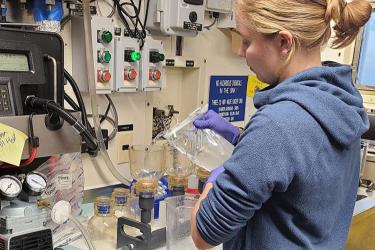The U.S. Fish & Wildlife Service (USFWS) recently issued two biological opinions on the effects of the groundfish fisheries off Alaska on certain seabird species listed under the Endangered Species Act. One opinion is at the programmatic level and addresses the effects of the Fishery Management Plans for the Gulf of Alaska (GOA) and the Bering Sea/Aleutian Islands (BSAI) groundfish fisheries on listed species. The other biological opinion is on the effects of the Total Allowable Catch (TAC)-setting process for the GOA and the BSAI groundfish fisheries on the listed species and includes incidental take limits for the endangered short-tailed albatross (Phoebastria albatrus), according to James W. Balsiger, Administrator, Alaska Region, NMFS.
Both opinions conclude that the GOA and BSAI fishery actions are not likely to jeopardize the continued existence of the short-tailed albatross or Steller's eider (Polysticta stelleri), or result in adverse modification of Steller's eider critical habitat. No critical habitat has been designated for the short-tailed albatross; therefore none will be affected. The USFWS also concurred with NMFS' determination that these actions are not likely to adversely affect the threatened spectacled eider (Somateria fischeri), based on this species' behavior and distribution relative to fishing activities in the BSAI and GOA. The biological opinions can be found on the Alaska seabird bycatch web page.
The USFWS anticipates that up to four short-tailed albatross could be taken every two years in the hook-and-line groundfish fishery off Alaska and that up to two short-tailed albatross could be taken in the groundfish trawl fishery off Alaska over the time period in which the biological opinion remains in effect (approx. 5 years). These incidental take limits are in addition to the take limit established in 1998 for the Pacific halibut hook-and-line fishery off Alaska, two short-tailed albatrosses in a two year period. If the level of anticipated take is exceeded in any of these fisheries, NMFS must immediately reinitiate a consultation with the USFWS to review the need for possible modification to the fishery. Modifications could range from changes to requirements for seabird avoidance measures to fishery closures. The exact modifications cannot be predicted at this time.
NMFS reminds fishermen using hook-and-line gear that seabird avoidance measures are required by regulation. Changes to the current requirements are forthcoming. A proposed rule (68 FR 6386, February 7, 2003) called for the use of paired streamer lines, with specified performance and material standards, for larger vessels. NMFS will publicize the new requirements.
When a short-tailed albatross is observed following a fishing vessel, every effort should be made to minimize the possibility of the bird becoming entangled with the gear. NMFS requests that you do the following:
- Change the vessel's heading or speed, to discourage the bird from following.
- If no sets are in progress: (1) avoid initiating a set while the bird is in sight and (2) avoid offal discharge in the presence of short-tailed albatross to discourage their association with the fishing vessel.
- If a short-tailed albatross appears to be attacking baited hooks despite the use of required bird avoidance mechanisms, gear should be deployed without bait, or gear deployment should be suspended, until the albatross discontinues attacks on the gear.
NMFS requests that fishermen continue to report all observations of short-tailed albatross to the USFWS via their reporting form.


